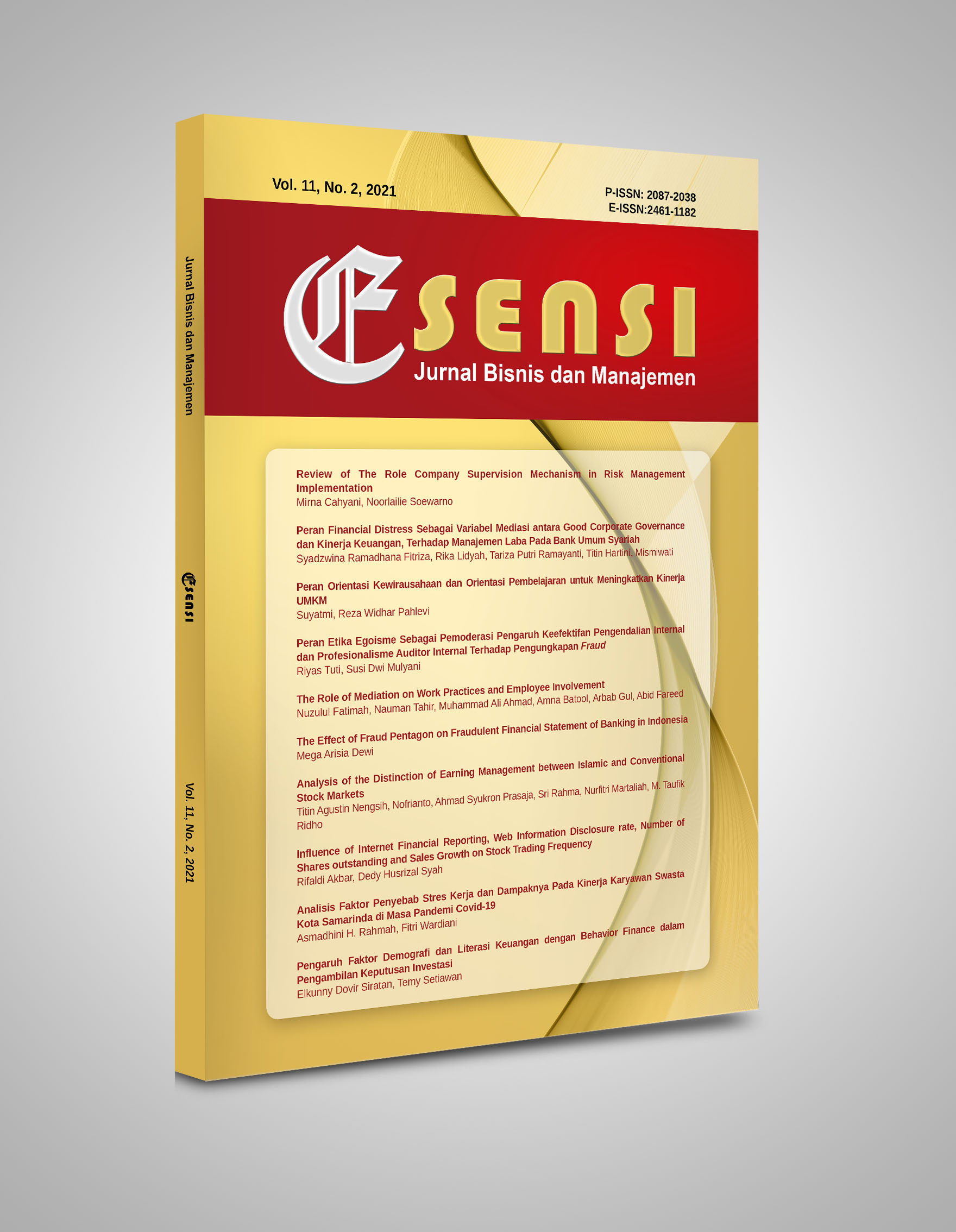Peran Orientasi Kewirausahaan dan Orientasi Pembelajaran untuk Meningkatkan Kinerja UMKM
DOI:
https://doi.org/10.15408/ess.v11i2.21826Keywords:
entrepreneurship orientation, learning orientation, competitive advantage, MSME performanceAbstract
This study aims to determine the effect of entrepreneurial orientation and learning orientation on competitive advantage; determine the effect of entrepreneurial orientation and learning orientation on performance and determine the effect of competitive advantage on performance. The data collection method was obtained by using a questionnaire on MSME actors in the Special Region of Yogyakarta and collected 204 respondents. The data analysis tool uses the AMOS Structural Equation Modeling (SEM) technique. The results show that there is an influence between entrepreneurial orientations and learning orientation on competitive advantage, there is an influence between entrepreneurial orientation and competitive advantage on performance. However, there is no effect between learning orientation on performanceReferences
Amin, M. (2015). The Effect Of Entrepreneurship Orientation And Learning Orientation On Smes’ Performance: An SEM – PLS Approach. Journal Of International Business And Entrepreneurship Development, 8(3), 215–230.
Barney, J. (1991). Firm Resources And Sustained Competitive Advantage. Journal Of Management, 17(1), 99–120.
Barret, P. (2007). Structural Equation Modelling: Adjudging Model Fit. Personality And Individual Differences, 42, 815–824.
Brettel, M. and Rottenberger, J.D. (2013). Examining The Link Between Entrepreneurial Orientation And Learning Processes In Small And Medium-Sized Enterprises. Journal of Small Business Management, Vol. 51, No. 4, pp.471–490.
Hair Jr., J. F., Black, W. C., Babin, B. J., & Anderson, R. E. (2013). Multivariate Data Analysis: Global Perspective. New Jersey: Pearson Prentice Hall.
Hernández-Perlines,F.,(2016).Entrepreneurial Orientation In Hotel Industry: Multi-Group Analysis Of Quality Certification. Journal Business.Research.69. 4714–4724
McCartan-Quinn, D. and Carson, D. (2003). Issues Which Impact Upon Marketing In The Small Firm’, Small Business Economics, Vol. 21, No. 2, pp.201–213.
MacGregor, R.C. (2004). Factors Associated With Formal Networking In Regional Small Business: Some Findings From A Study Of Swedish SMEs. Journal of Small Business and Enterprise Development, Vol. 11, No. 1, pp.60–74.
Mahmmod, R. dan N. Hanafi. (2013). Entrepreneurial Orientation and Business Performance of Women-Owened Small and Medium Enterprises in Malaysia: Competitive Adavantage as A Mediator. International Journal of Business and Social Science 4(1): 82-90.
Martin,S.L., and Javalgi, R.G., (2016). Entrepreneurial Orientation, Marketing Capabilities And Performance: The Moderating Role Of Competitive Intensity On Latin American International New Ventures. Journal Business.Research. 69, 2040–205
Muafi dan Roostika, Ratna. (2014). Organizational Performance and Competitive Advantage Determinants of Creative SMEs. European Journal Of Economics And Management , Vol. 1, No. 2, pp.7-25
Mustafa, M., et al. (2015). Risk Factor, Diagnosis, and Management of Peptic Ulcer Disease. IOSR Journal of Dental and Medical Science. Sabah, Malaysia
Mustikowati, Rita Indah dan Irma Tysari. (2014). Orientasi Kewirausahaan, Inovasi, Dan Strategi Bisnis Untuk Meningkatkan Kinerja Perusahaan (Studi Pada UKM Sentra Kabupaten Malang). Modernisasi. Volume 10, Nomor 1, Februari 2014
Real, J.C., Roldán, J.L. and Leal, A. (2012). From Entrepreneurial Orientation And Learning Orientation To Business Performance: Analysing The Mediating Role Of Organizational Learning And The Moderating Effects Of Organizational Size. British Journal of Management, pp.1–23, DOI: 10.1111/j.1467-8551.2012.00848.x
Rhee, J., Park, T. and Lee, D.H. (2010). Drivers Of Innovativeness And Performance For Innovative Smes In South Korea: Mediation Of Learning Orientation’, Technovation, Vol. 30, No. 1, pp.65–75.
Saleh, A.S. and Ndubisi, N.O. (2006). An Evaluation Of SME Development In Malaysia’, International Review Of Business Research Papers, Vol. 2, No. 1, pp.1–14.
Salleh, F. and Ibrahim, M.D. (2013). The Relationship Between Risk-Taking Propensity And Demographic Characteristics Among Mses In Malaysia. Journal For Global Business Advancement, Vol. 6, No. 1, pp.38–49
Shepherd, D., & Wiklund, J. (2009). Are We Comparing Apples With Apples Or Apples With Oranges? Appropriateness Of Knowledge Accumulation Across Growth Studies. Entrepreneurship Theory And Practice, 33(1), 105–123.
Wang, C.L. (2008). Entrepreneurial Orientation, Learning Orientation, And Firm Performance’, Entrepreneurship Theory And Practice, Vol. 32, No. 4, pp.635–657.
Wijetunge, W A.D.S. (2016). Service Quality Competitive Advantage and Business Performance in Service Providing SMEs in Sri langka. Internasional Journal of Scientific and Research Publications, Volume 6 Issue 7
Wiklund, J. (1999). The Sustainability Of The TQ: Entrepreneurial Orientation-Performance Relationship. Entrepreneurship Theory, and Practice, Fall, pp.37–48
Wiklund, J. and Shepherd, D. (2003). Entrepreneurial Orientation And Small Business Performance: A Configurational Approach. Journal of Business Venturing, Vol. 20, No. 1, pp.71–91.
Zhao, Y., Li, Y., Lee, S.H. and Chen, L.B. (2011) ‘Entrepreneurial orientation, organizational learning, and performance: evidence from China’, Entrepreneurship Theory and Practice, Vol. 35, No. 2, pp.293–317.
Zhou, KZ. Brown, JR. Dev, CS (2009). Market Orientation, Competitive Advantage And Performance : A Demand-Based Perspective. Journal Of Business Research, 2009, V 62 n 11, p. 1063-1070

